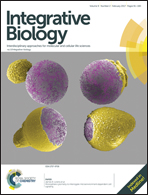A computational model predicts genetic nodes that allow switching between species-specific responses in a conserved signaling network†
Abstract
Cell signaling networks regulate a variety of developmental and physiological processes, and changes in their response to external stimuli are often implicated in disease initiation and progression. To elucidate how different responses can arise from conserved signaling networks, we have developed a mathematical model of the well-characterized Caenorhabditis vulval development network involving EGF, Wnt and Notch signaling that recapitulates biologically observed behaviors. We experimentally block a specific element of the EGF pathway (MEK), and find different behaviors in vulval development in two Caenorhabditis species, C. elegans and C. briggsae. When we separate our parameters into subsets that correspond to these two responses, they yield model behaviors that are consistent with observed experimental results, despite the initial parameter grouping based on perturbation in a single node of the EGF pathway. Finally, our analysis predicts specific parameters that may be critical for the theoretically and experimentally observed differences, suggesting modifications that might allow intentional switching between the two species' responses. Our results indicate that all manipulations within a signal transduction pathway do not yield the same outcome, and provide a framework to identify the specific genetic perturbations within a conserved network that will confer unique behaviors on the network.



 Please wait while we load your content...
Please wait while we load your content...